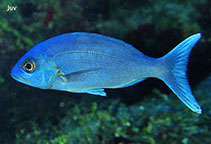| Family: |
Lutjanidae (Snappers), subfamily: Apsilinae |
| Max. size: |
65 cm TL (male/unsexed); max.weight: 3,170.0 g |
| Environment: |
reef-associated; marine; depth range 40 - 300 m |
| Distribution: |
Western Central Atlantic: West Indies, Florida Keys, western Gulf of Mexico, western Caribbean (off Belize), probably more widespread in Caribbean (Anderson, pers. comm.). |
| Diagnosis: |
Dorsal spines (total): 10-10; Dorsal soft rays (total): 9-10; Anal spines: 3-3; Anal soft rays: 8-8. The snout is relatively short and pointed. Anterior teeth in upper jaw enlarged, canine-like. Interorbital space convex. Dorsal and anal fin bases without scales. Pectoral fins long reaching level of anus. Scale rows on back parallel to lateral line. The back and upper sides violet or dark brown becoming lighter ventrally. Juveniles are mainly blue in color. |
| Biology: |
Adults inhabit mainly rocky bottoms. Young sometimes found near the surface. Feed on fishes and benthic organisms, including cephalopods and tunicates. Flesh of good quality; marketed fresh and frozen. |
| IUCN Red List Status: |
Least Concern (LC); Date assessed: 04 February 2009 Ref. (130435)
|
| Threat to humans: |
reports of ciguatera poisoning |
Source and more info: www.fishbase.org. For personal, classroom, and other internal use only. Not for publication.
